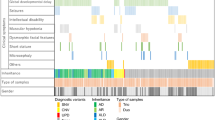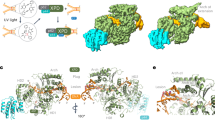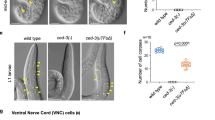Abstract
Trichothiodystrophy (TTD) is a rare autosomal recessive disorder characterized by sulfur-deficient brittle hair complicated with ichthyosis, physical and mental retardation, and proneness to infections. Approximately half of TTD patients exhibit cutaneous photosensitivity because of the defect of nucleotide excision repair. Three genes, XPB, XPD and TTDA, have been identified as causative genes of photosensitive TTD. These three genes are components of basal transcription factor IIH. Most TTD cases have been reported in Europe and North America. We report a severely affected Japanese TTD patient with XPD mutations. Interestingly, his father has ichthyotic skin. The alteration in the paternal allele was a nucleotide substitution leading to Arg-722 to Trp (R722W), as previously reported in TTD patients. The other alteration in the maternal allele was a novel 3-bp deletion at nucleotides 67–69, resulting in the deletion of Ser-23, which is located upstream of helicase motif I and is the closest to the N-terminal end of XPD in reported mutations. The expression study showed that the two alterations were causative mutations for TTD. In Asia, it is likely that there are TTD patients who have not been diagnosed.
Similar content being viewed by others
Log in or create a free account to read this content
Gain free access to this article, as well as selected content from this journal and more on nature.com
or
References
Stefanini, M., Botta, E., Lanzafame, M. & Orioli, D. Trichothiodystrophy: from basic mechanisms to clinical implications. DNA Repair 9, 2–10 (2010).
Hashimoto, S. & Egly, J. M . Trichothiodystrophy view from the molecular basis of DNA repair/transcription factor TFIIH. Hum. Mol. Genet. 18, R224–R230 (2009).
Lehmann, A. R . The xeroderma pigmentosum group D (XPD) gene: one gene, two functions, three diseases. Genes Dev. 15, 15–23 (2001).
Faghri, S., Tamura, D., Kraemer, K. H. & DiGiovanna, J. J . Trichothiodystrophy: a systematic review of 112 published cases characterises a wide spectrum of clinical manifestations. J. Med. Genet. 45, 609–621 (2008).
Kobayashi, T., Kuraoka, I., Saijo, M., Nakatsu, Y., Tanaka, A., Someda, Y. et al. Mutations in the XPD gene leading to xeroderma pigmentosum symptoms. Hum. Mutat. 9, 322–331 (1997).
Kobayashi, T., Uchiyama, M., Fukuro, S. & Tanaka, K. Mutations in the XPD gene in xeroderma pigmentosum group D cell strains: confirmation of genotype-phenotype correlation. Am. J. Med. Genet. 110, 248–252 (2002).
Kobayashi, T. & Uchiyama, M. Characterization of assembly of recombinant type IV collagen α3, α4, and α5 chains in transfected cell strains. Kidney Int. 64, 1986–1996 (2003).
Moslehi, R., Signore, C., Tamura, D., Mills, J. L., DiGiovanna, J. J., Tucker, M. A . et al. Adverse effects of trichothiodystrophy DNA repair and transcription gene disorder on human fetal development. Clin. Genet. 77, 365–373 (2010).
Broughton, B. C., Steingrimsdottir, H., Weber, C. A. & Lehmann, A. R . Mutations in the xeroderma pigmentosum group D DNA repair/transcription gene in patients with trichothiodystrophy. Nat. Genet. 7, 189–194 (1994).
Takayama, K., Salazar, E. P., Broughton, B. C., Lehmann, A. R., Sarasin, A., Thompson, L. H . et al. Defects in the DNA repair and transcription gene ERCC2 (XPD) in trichothiodystrophy. Am. J. Hum. Genet. 58, 263–270 (1996).
Botta, E ., Nardo, T., Broughton, B. C., Marinoni, S., Lehmann, A. R. & Stefanini, M. Analysis of mutations in the XPD gene in Italian patients with trichothiodystrophy: site of mutation correlates with repair deficiency, but gene dosage appears to determine clinical severity. Am. J. Hum. Genet. 63, 1036–1048 (1998).
Viprakasit, V., Gibbons, R. J., Broughton, B. C., Tolmie, J. L., Brown, D., Lunt, P. et al. Mutations in the general transcription factor TFIIH result in β-thalassaemia in individuals with trichothiodystrophy. Hum. Mol. Genet. 10, 2797–2802 (2001).
Boyle, J., Ueda, T., Oh, K. S., Imoto, K., Tamura, D., Jagdeo, J. et al. Persistence of repair proteins at unrepaired DNA damage distinguishes diseases with ERCC2 (XPD) mutations: cancer-prone xeroderma pigmentosum vs. non-cancer-prone trichothiodystrophy. Hum. Mutat. 29, 1194–1208 (2008).
Botta, E., Nardo, T., Orioli, D., Guglielmino, R., Ricotti, R., Bondanza, S. et al. Genotype-phenotype relationships in trichothiodystrophy patients with novel splicing mutations in the XPD gene. Hum. Mutat. 30, 438–445 (2009).
Taylor, E. M., Broughton, B. C., Botta, E., Stefanini, M., Sarasin, A., Jaspers, N. G. J et al. Xeroderma pigmentosum and trichothiodystrophy are associated with different mutations in the XPD (ERCC2) repair/transcription gene. Proc. Natl. Acad. Sci. USA 94, 8658–8663 (1997).
Fan, L., Fuss, J. O., Cheng, Q. J., Arvai, A. S., Hammel, M., Roberts, V. A et al. XPD helicase structures and activities: insights into the cancer and aging phenotypes from XPD mutations. Cell 133, 789–800 (2008).
Liu, H., Rudolf, J., Johnson, K. A., McMahon, S. A., Oke, M., Carter, L. et al. Structure of the DNA repair helicase XPD. Cell 133, 801–812 (2008).
Sandrock, B. & Egly, J. M . A yeast four-hybrid system identifies cdk-activating kinase as a regulator of the XPD helicase, a subunit of transcription factor IIH. J. Biol. Chem. 276, 35328–35333 (2001).
Kleijer, W. J., Laugel, V., Berneburg, M., Nardo, T., Fawcett, H., Gratchev, A. et al. Incidence of DNA repair deficiency disorders in western Europe: xeroderma pigmentosum, Cockayne syndrome and trichothiodystrophy. DNA Repair 7, 744–750 (2008).
Author information
Authors and Affiliations
Corresponding author
Rights and permissions
About this article
Cite this article
Usuda, T., Saijo, M., Tanaka, K. et al. A Japanese trichothiodystrophy patient with XPD mutations. J Hum Genet 56, 77–79 (2011). https://doi.org/10.1038/jhg.2010.123
Received:
Revised:
Accepted:
Published:
Issue date:
DOI: https://doi.org/10.1038/jhg.2010.123
Keywords
This article is cited by
-
Novel ERCC2 variant in trichothiodystrophy infant: the first case report in China
BMC Pediatrics (2021)



